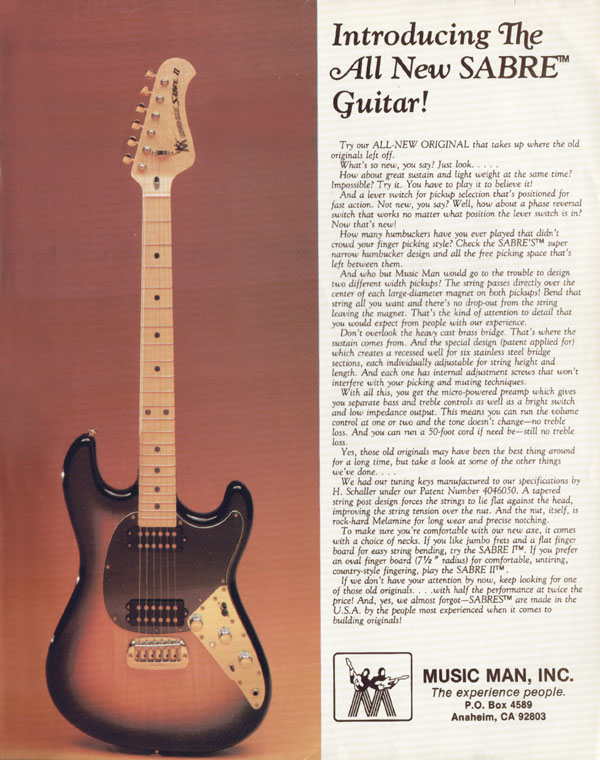
Try our ALL-NEW ORIGINAL that takes up where the old originals left off.
What's so new, you say! Just look. ....
How about great sustain and light weight at the same time? Impossible! Try it. You have to play it to believe it
And a lever switch for pickup selection that's positioned for fast action. Not new, you say? Well, how about a phase reversal switch that works no matter what position the lever switch (5 in? Now that's new.'
How many humbuckers hare you ever played that didn't crowd your finger picking style? Check the SABRE'Sâ„¢ super narrow humbucker design and ail the free picking space that's left between them.
And who but Music Man wouid go to the trouble to design two different width pickups' The string passes directly over the center of each large-diameter magnet on both pickups' Bend that string all you want and there's no drop-out from the string leafing the magnet. That's the kind of attention to detail that you would expect from people with our experience.
Don't overlook (he heavy cast brass bridge. That's where the sustain comes from. And the special design (patent applied for) which creates a recessed well for six stainless stee! bridge sections, each individually adjustable for string height and length. And each one has internal adjustment screws that won't interfere with your picking and muting techniques.
With all this, you get the micro-powered preamp which gives you separate bass and treble controls as well as a bright switch and low impedance output. This means you can run the volume control at one or two and the tone doesn't change—no treble loss. And you can run a 50-foot cord if need be—still no treble loss.
Yes, those old originals may have been the best thing around for a long time, but take a look at some of the other things we've done. . . .
We had our tuning keys manufactured to our specifications by H. Schaller under our Patent Number 4046050. A tapered string post design forces the strings to lie flat against the head, improving the string tension over the nut. And the nut, itself, is rock-hard Melamine for long wear and precise notching.
To make sure you're comfortable with our new axe, it comes with a choice of necks. If you like jumbo frets and a flat finger board for easy string bending, Cry the SABRE Tâ„¢. If you prefer an oval finger board (7V2 " radius) for comfortable, untiring, country-style fingering, play the SABRE JF".
If we don't have your attention by now, keep looking for one of those old originals. . . .with half the performance at twice the price? And, yes, we almost forgot— SABRES™ are made in the U.S.A. by the people most experienced when it comes to building originals

£299
£3220
£1090
€950
€2150